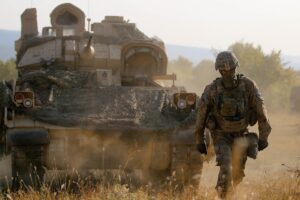The Army has completed initial concept reviews with the competitors vying for the Optionally Manned Fighting Vehicle (OMFV) program, a first major milestone in the Bradley replacement effort.
Jim Schirmer, the Army’s deputy program executive officer for ground combat systems, told reporters on Tuesday the reviews were completed a few weeks ago and lead program officials are now assessing the OMFV offerings to inform further refinement of the vehicle’s requirements.

“[The competitors] provided a stack of data and said ‘Hey, here’s our concept. Here’s what it looks like. And here’s the data that goes with it. Here’s the powertrain. Here’s the horsepower. Here’s what we think it’s going to weigh.’ Those sorts of things,” Schirmer told reporters during a briefing at the Association of the United States Army (AUSA) conference.
In July, the Army awarded nearly $300 million in contracts to General Dynamics Land Systems [GD], Oshkosh Defense [OSK], BAE Systems, Rheinmetall and armor supplier Point Blank Enterprises to work on refining their OMFV concepts over the next 15 months (Defense Daily, July 23).
This the Army’s second attempt at OMFV, with the rebooted effort focused on bolstering industry feedback on program specifications, asking vendors to submit proposals based on nine broad characteristics rather than providing a stringent set of requirements.
Schirmer said the data from the initial reviews has now been given to the Army’s Ground Vehicle Systems Center to work the information through modeling tools to help with the refining of OMFV requirements and then provide an assessment of the concepts.
“That assessment’s going to take longer. I don’t know exactly how long, but a few weeks. And then we’ll feed that data back to the [Next-Generation Combat Vehicle Cross Functional Team] and also back to the contractors,” Schirmer said.
The data assessment along with feedback provided directly from lead program officials will drive the competitors’ iterative work on their concepts, according to Schirmer.
“They’re starting to pursue alternative iterations in anticipation of where they think we’re going to go. There is a risk that someone will guess wrong once we actually start to narrow our focus and detail what requirements we’re starting to lean toward,” Schirmer.
Maj. Gen. Ross Coffman, director of the Next-Generation Combat Vehicle Cross-Functional Team, also told reporters Army officials have also been meeting directly with OMFV competitors on the floor at AUSA to discuss their approaches to the program and provide additional feedback.
“They got clear, clear guidance at AUSA from me. The government’s paying them money to iterate with this and we’re trying to determine what’s in the realm of the possible and sharpen our requirements,” Coffman said.
BAE Systems told reporters ahead of the AUSA conference their OMFV concept is based on a new vehicle design, and the company has brought a “rolling lab” technology demonstrator to the show that shows the plug-in-play capability approach afforded by the company’s modular open architecture emphasis and highlights advanced technologies that could play a part in a potential OMFV platform (Defense Daily, Oct. 11).
A Request for Proposals for the next two phases of OMFV is set to be released next summer, according to Coffman, where the service will then select up to three vendors in the second quarter of fiscal year 2023 to move onto the design review period followed by a physical prototype testing phase.